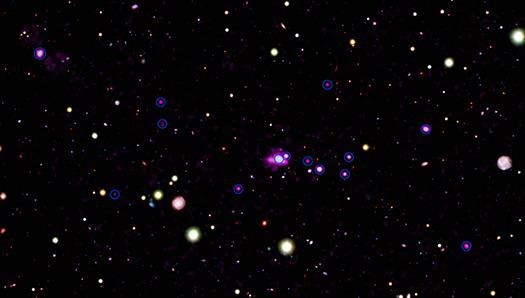Generally, when thinking of a spiderweb, one thinks of prey trapped and soon to be devoured by a predator. With the "Spiderweb" protocluster, however, objects that are found inside an enormous cosmic web are devouring and growing, according to information from NASA's Chandra X-Ray Observatory.
 14 sources detected by Chandra (Credit: X-ray: NASA/CXC/INAF/P. Tozzi et al; Optical (Subaru): NAOJ/NINS; Optical (HST): Image Credit: NASA/STScI)
14 sources detected by Chandra (Credit: X-ray: NASA/CXC/INAF/P. Tozzi et al; Optical (Subaru): NAOJ/NINS; Optical (HST): Image Credit: NASA/STScI)
The Spiderweb galaxy, officially termed J1140-2629, acquired its name because of its web-like structure seen in certain optical light images. This similarity can be observed in the inset box where information from NASA's Hubble Space Telescope displays galaxies in white, orange and blue, and information from Chandra is in purple.
Situated approximately 10.6 billion light-years from Earth, the Spiderweb galaxy is at the focal point of a protocluster, an emergent collection of galaxies and gas that will ultimately turn into a galaxy cluster.
To hunt for emergent black holes in the Spiderweb protocluster, a group of scientists watched it for more than eight days with Chandra. In the central panel of this graphic, a composite picture of the Spiderweb protocluster shows X-Rays spotted by Chandra (also in purple) that have been integrated with optical information from the Subaru telescope on Mauna Kea in Hawaii (green, red, and white). The big image is 11.3 million light-years across.
The majority of the "blobs" in the optical picture are galaxies in the protocluster, including 14 that have been spotted in the latest, deep Chandra image. These X-Ray sources expose the existence of material falling toward supermassive black holes comprising hundreds of millions of times more mass than the Sun.
The Spiderweb protocluster occurs at a period in the Universe that astronomers call "cosmic noon." Researchers have learned that during this time — approximately 3 billion years after the big bang — galaxies and black holes were experiencing extreme growth.
The Spiderweb seems to be surpassing the high standards of even this dynamic period in the Universe. The 14 sources discovered by Chandra suggest that around 25% of the most gigantic galaxies comprise dynamically growing black holes. This is between five and twenty times more than the fraction found for other galaxies of comparable age and with about the same array of masses.
These outcomes indicate that certain environmental influences are accountable for the large number of quickly developing black holes in the Spiderweb protocluster. One reason could be that a high rate of interactions and collisions between galaxies is sweeping gas toward the black holes at the focal point of each galaxy, offering large quantities of material to devour.
Another description is that the protocluster still comprises large amounts of cold gas that is more effortlessly devoured by a black hole than hot gas (this cold gas gets heated as the protocluster turns into a galaxy cluster).
A comprehensive study of Hubble data may offer crucial clues regarding the reasons for the large number of quickly evolving black holes in the Spiderweb protocluster. Spreading this exploration to other protoclusters would also necessitate the precise X-Ray vision of Chandra.
An article narrating these findings has been recognized for publication in the journal Astronomy and Astrophysics and a preprint is available online. The study’s first author is Paolo Tozzi from the National Institute for Astrophysics in Arcetri, Italy.
NASA's Marshall Space Flight Center runs the Chandra program. The Smithsonian Astrophysical Observatory's Chandra X-Ray Center manages flight operations from Burlington, Massachusetts and science operations from Cambridge, Massachusetts.
Quick Look: Feasting Black Holes Caught in Galactic Spiderweb
Video Credit: The Chandra X-ray Center, Smithsonian Astrophysical Observatory, Harvard University
Journal Reference:
Tozzi, P., et al. (2022) The 700 ks Chandra Spiderweb Field I: evidence for widespread nuclear activity in the Protocluster. Astronomy and Astrophysics. doi.org/10.48550/arXiv.2203.02208.